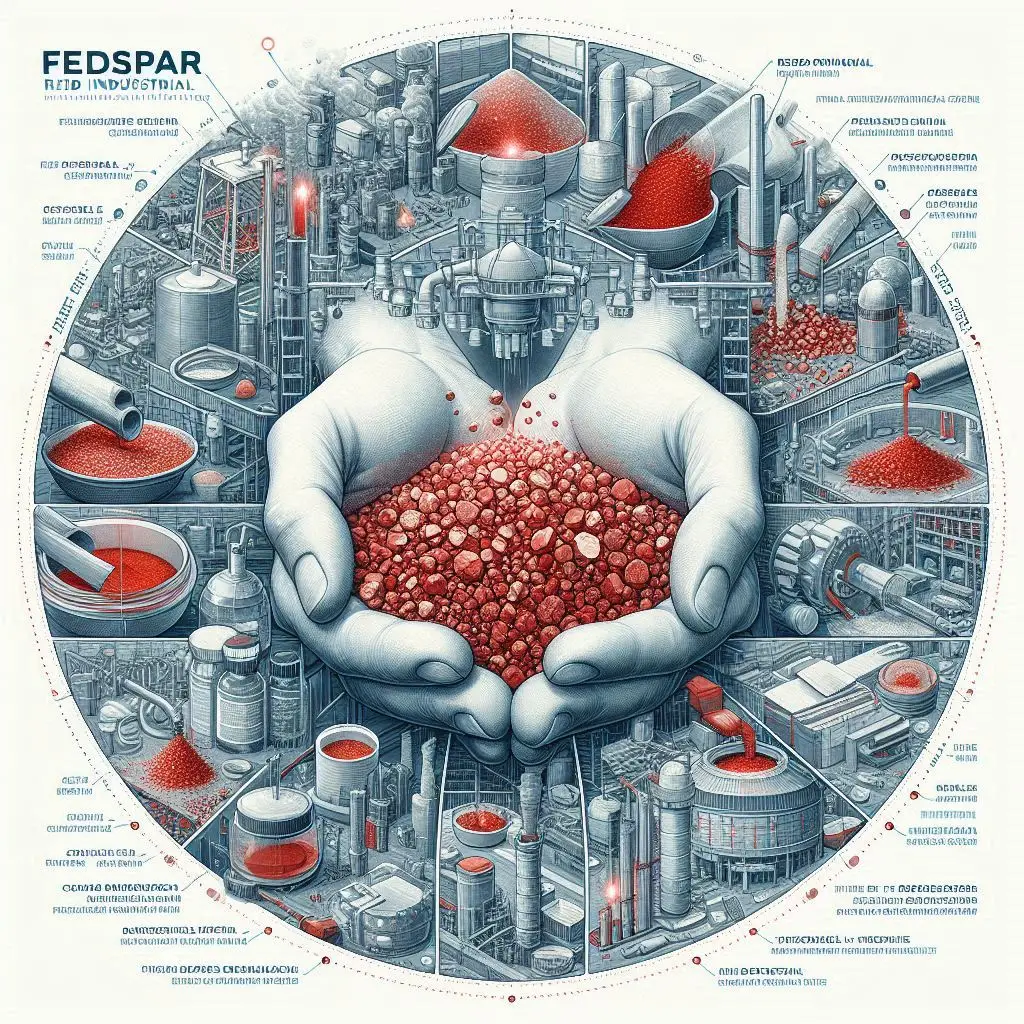
Uses of feldspar mineral in ceramics red industrial
Introduction
This article, explores the various uses of feldspar mineral, focusing on its roles in ceramics, red ceramics, and broader industrial applications.
Feldspar is a vital mineral used in a wide range of industrial applications, with its importance most prominently recognized in ceramics, red ceramics, and various other industrial uses. This mineral’s chemical composition, which primarily includes aluminum silicates combined with potassium, sodium, or calcium, makes it indispensable in various sectors. From traditional ceramics to high-tech industries, feldspar’s unique properties allow it to serve as a key ingredient that enhances product quality and performance.
Uses of Feldspar Mineral
The uses of feldspar mineral are extensive, making it one of the most important industrial minerals in the world. Feldspar is primarily utilized in the production of glass and ceramics due to its ability to act as a fluxing agent. This mineral lowers the melting temperature of a mixture, making it an essential component in manufacturing processes that require high-temperature operations.
Beyond glass and ceramics, feldspar is also employed in the production of various other products. In paints, it acts as a filler and extender, improving the product's durability and consistency. In plastics, feldspar increases the material’s hardness and chemical resistance. The mineral is also found in the production of rubber, adhesives, and sealants, where it enhances product performance by improving physical properties such as strength and resistance to wear and tear.
Feldspar is even utilized in agriculture, where it is added to fertilizers to provide potassium, an essential nutrient for plant growth. This versatility underscores the mineral's widespread use across numerous industries, making feldspar a cornerstone in the manufacturing sector.
Uses of Feldspar in Ceramics
The uses of feldspar in ceramics are particularly significant, given that this mineral is one of the main ingredients in the ceramic industry. Feldspar is used in ceramic production as a flux, a material that helps control the melting process. By lowering the melting temperature of other components, feldspar facilitates the formation of a glassy phase during firing, which is crucial for the strength and durability of ceramic products.
In ceramic glazes, feldspar contributes to the surface finish and aesthetic properties, providing a smooth and glossy appearance. This mineral is essential in the production of various types of ceramics, including porcelain, earthenware, and stoneware. Its presence ensures that the final product is not only visually appealing but also structurally sound.
Furthermore, feldspar’s role in ceramics extends to its use in tile production. The mineral helps in achieving the desired texture and hardness in tiles, making them suitable for both residential and commercial applications. Feldspar’s ability to act as a flux and its contribution to the vitrification process make it indispensable in the creation of high-quality ceramic products.
Uses of Feldspar Red
The uses of feldspar red are particularly notable in specific types of ceramic and glass products, where the mineral’s red or reddish tint plays a crucial role in the final appearance of the product. Feldspar red is often used in the production of red ceramics, which are commonly seen in traditional pottery and decorative items. The red hue is achieved through the presence of iron oxides in the feldspar, which gives the final product its distinctive color.
In addition to ceramics, feldspar red is also used in the glass industry to create colored glass products. The mineral’s ability to provide a consistent color without compromising the glass’s clarity or quality makes it a valuable component in colored glass production. This use is particularly prevalent in the manufacturing of glass bottles, containers, and decorative glass items, where a specific color is desired.
The applications of feldspar red extend beyond aesthetics. In some cases, the red variant of feldspar is chosen for its specific chemical properties, which can enhance the thermal and mechanical characteristics of the final product. This makes it suitable for use in applications where both color and performance are critical factors.
Industrial Uses of Feldspar
The industrial uses of feldspar are diverse and far-reaching, making it a critical mineral in various sectors. In addition to its prominent role in ceramics and glass production, feldspar is used in a wide range of industrial applications that leverage its unique chemical and physical properties.
In the paint industry, feldspar is used as a filler and extender, helping to improve the product's consistency and durability. The mineral’s ability to provide a smooth, uniform texture makes it ideal for use in high-quality paints. Feldspar also enhances the paint’s resistance to environmental factors, such as moisture and UV radiation, which can degrade the product over time.
The rubber and plastics industries also benefit from feldspar’s properties. When added to rubber, feldspar improves the material’s strength and elasticity, making it more durable and resistant to wear. In plastics, feldspar increases the material’s hardness and chemical resistance, contributing to the production of high-performance plastic products that can withstand demanding conditions.
Additionally, feldspar is utilized in the manufacturing of fiberglass, where it enhances the material's strength and resilience to heat stress. Because of this, fiberglass goods may be used in a variety of industries, such as the aerospace, automotive, and construction sectors. Furthermore, feldspar is used in the creation of ceramics for electrical insulators, where its low electrical conductivity and strong dielectric strength are crucial for guaranteeing the dependability and security of electrical parts.
Conclusion
Feldspar is an incredibly versatile mineral with a wide range of uses across various industries. Its role in ceramics, both traditional and red variants, highlights its importance in creating aesthetically pleasing and durable products. The industrial applications of feldspar extend even further, with its presence in glass, paints, plastics, rubber, and other materials proving crucial for enhancing product performance and quality. As a fluxing agent, filler, and coloring agent, feldspar’s contributions to the manufacturing sector cannot be overstated. Its unique properties make it an indispensable component in the production of high-quality goods, ensuring that feldspar remains a key mineral in the global industrial landscape.

